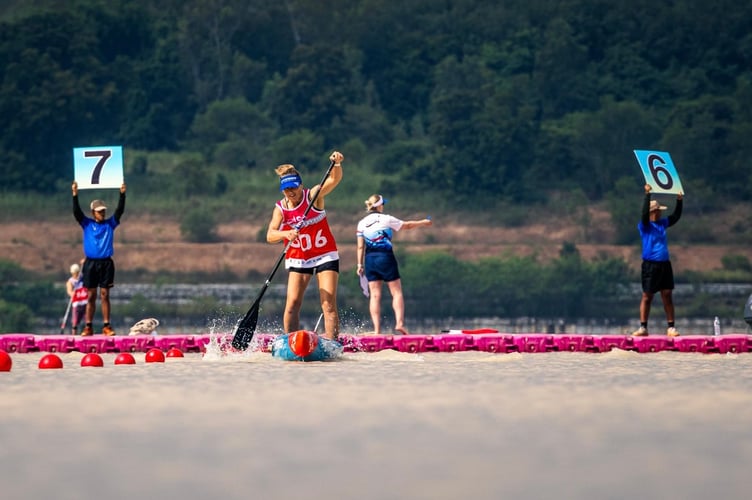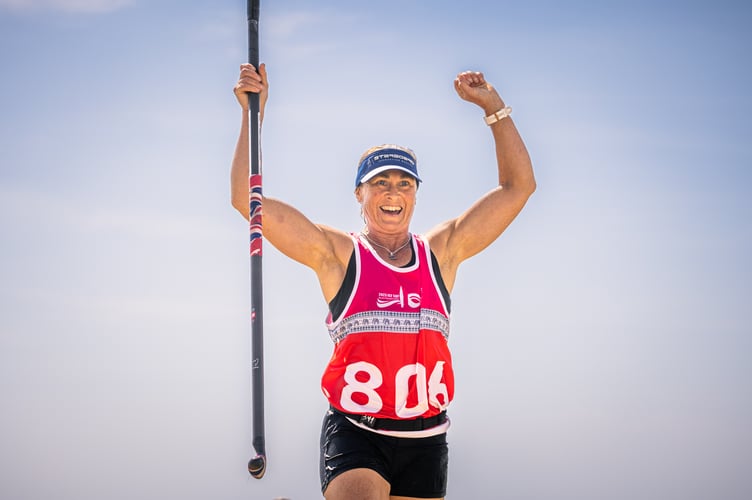One of the biggest draws to the South Hams is its beaches, rivers, and estuaries, and we are very lucky that we live on their doorstep. By having unfettered access to some of the most idyllic beaches in the country it makes the South Hams one the hubs for water sports in the UK. During the racing season we host some of the biggest events in the water sport calendar with the Head of the Dart being one of the highlights. South Hams reporter Aaron Griffin sat down with Salcombe’s double gold medal-winning paddleboarding world champion and coach, Marie Buchanan, on the banks of the Dart in Totnes to talk about her SUP, stand up paddleboarding, successes, what the sport needs to grow and why the South Hams is one of the best places to learn and train for water sports.
AG: “Can you tell me a bit about yourself outside of SUP?”
MB: “I’m a trained physio and I used to work in the South Hams hospital in the musculoskeletal department. Just before covid I gave that up to pursue my own business which is a mixture of water sports coaching and I’m also a commercial fisherwoman. I work in Salcombe and Hope cove, in the summer we fish out of Hope cove, for lobsters mainly, and in the winter, we fish for scallops.”
AG: “How did you get into paddleboarding?”
MB: “I was one of the early uptakes of paddleboarding in the UK, before I was a competitive paddleboarder I was a competitive windsurfer. I moved back to Devon the same year I took up paddleboarding, I was born in Exeter. I always wanted to come back here to live, I did my physio training in Cardiff, then I applied for jobs down here and got a job in Kingsbridge, where I worked for 12 years. It was the same year that I was looking for a way to explore the water, because when we lived down here as a family we used to go sailing and travel along the coast and explore the different harbours from Brixham down to Falmouth. SUP came along and I saw it as an amazing way of getting onto the water and exploring all the nooks and crannies that you couldn’t necessarily do as a windsurfer. Because I was already competitive on the water someone suggested racing and I think later on in the year I did my first SUP race down at Watergate Bay. I won the distance race and from then I was hooked really.”

AG: “Can you tell me about the different disciplines in SUP?”
MB: “There’s a huge variety of different SUP races, there are three main disciplines, a sprint over 200m, which is an all out sprint in lanes, it's not my favourite one. The long distance which is a stretched out course on the sea, with a minimum distance of 10km but they can be anything up to 20km, 30km or even 220km, I did one of those races in Holland over 5 days. The final discipline is the technical race, which is 1000km and that is run around 5 buoys and you turn in different directions, combining skill, speed and transitions. You start from the beach and dismount for a beach sprint to the finish line, the beach start is a unique feature to the technical races. At international level, you will have separate starts and heats for men and women, and you have separate age categories, junior, open, which is 18-40, 40+ and 50+.”
AG: “What is it you prefer about SUP to other water sports?”
MB: “I love the sea and I love the waves, I’ve also competed for Team GB in the SUP surfing, SUP surfing is effectively stand up surfing but with a paddle. The windsurf is where my strength is really, not just from the paddling but that’s come from a lifelong love of sailing, windsurfing, surfing, it’s all combined to give me those skills. I guess its extended my competitiveness because it’s not just about fitness, it’s about your knowledge of the water and being able to read the water.”
AG: “Can you tell about the Technology behind the boards and how it has developed in recent years?”
MB: “Since I started in 2007 the construction of boards and the design of boards has changed phenomenally. There are multiple manufacturers that have developed the sport very quickly. When I started it was a round nosed hardboard similar to a surfboard, with a flat deck, very simple and reasonably wide, because the shape needed to give you stability to stand up and paddle. Then in about 2009, inflatables came about and that really allowed more people to get involved with SUP as a leisure activity. They’re great really because they allow everyone to have a go. They allow you to get on the water anywhere, on lakes, rivers and the sea, but they aren’t as fast as a race board. In terms of racing, the boards have evolved to a much more pointy and much narrower boards, a bit like skis, the narrower the board the faster it will go. To be more stable they have developed dug outs which put your feet at water level, bringing your centre of gravity lower so you can get away with a much narrower board.”
AG: “How light are the boards?”
MB: “For races they have to be over 10kgs, so they range between 10 and 14kgs.”
AG: “Are there advantages and disadvantages to having it heavier or lighter?”
MB: “The lighter you have it, its easier to handle at the start, in lighter winds it gives you better glide on the water. If its windy I’d rather be on a heavier board, to be honest, as you have better stability.”
AG: “What about the length of the board?”
MB: “Most racers go with the 14ft, the longer the board the better the glide and faster it is.”
AG: “Do the boards have any divots for your feet?”
MB: “They have experimented with that in the past, there was a board that had 2 feet wells. But it was very restrictive, if you’re trying to downwind, which is when you switch your stance to your feet facing to the side rather than forwards, when catching a bump in the ocean, having wells would make that very difficult.”
AG: “How difficult is it stay balanced whilst trying to go as quickly as possible?”
MB: “You need to find the right board for you. It is easy to make the mistake to get a board too narrow, thinking it will make you go faster, but you’re only ever as fast as you are able to stay on top of the board if you fall in. I think 21 inches wide is as narrow as I would want to go.”
AG: “Are there any rules against wearing footwear in a race?”
MB: “No, you can wear whatever you like. Personally, I think having bare feet gives you the best contact with the board and gives you the best feedback through your feet. The thin soles disrupt that for me. Most boards have deck pads on them with textured pads to stand on.”

AG: “What support does the sport have from governing bodies in the country?”
MB: “We’ve only just gained a governing body which is British canoeing and Surfing England. They are a split governing body. They’re trying to get it to the Olympics, but it hasn’t reached that status, it’s just been declined from the 2028 LA Olympics. Surfing is in it for 2024, I’m not sure if they can appeal the decision.”
AG: “Do you think we will ever see the sport at the Olympics?”
MB: “Yeah, I think we will. Either in its current format or in a surf format.”
AG: “What do you think the sport needs to get more exposure?”
MB: “I think from a UK point of view, we are really missing juniors. I think it’s because the cost of race boards is so expensive. When you go to a race event in the UK its very much dominated by people that can afford it, people my age and people that have an income. There are a few juniors, but they obviously rely on their parents and there isn’t that pathway for juniors to come up, it’s very much if you’re lucky and your local club will run junior racing and clubs.”
AG: “Does the sport have lottery funding?”
MB: “No and I think that’s the problem, until it gets Olympic status Sport England won’t give us any funding. I’ve just been on Spotlight and BBC Radio Devon, just because I want to try and raise its awareness because people don’t know it’s a sport.”
AG: “Where are the clubs in the UK?”
MB: “They are spread out. A lot of the clubs are inland, and a lot of our races are inland. Because that’s where the majority of people race. A lot of the people are based in the south west, we’ve got really strong paddlers in our area, because we go out in the sea and surf, but that is rare. I think what we need is funding to enable clubs to have access to boards that juniors can race on.”
AG: “Where’s your favourite place to race or train?”
MB: “To train its obviously in Salcombe or Bantham, we’re really spoilt with different locations depending on what the conditions are. I’m especially spoilt in Salcombe because if its blowing old boots, which it has done a lot lately, I can just stay in the estuary, but I can still get exposure to the wind and the bumps safely. But Waterborne, my local club, host one of the biggest SUP races which has just been actually, SUP the creek. That has to be one of my favourite races. That and the head of the Dart, we’re really lucky to have two really good local races.”
AG: “What is it about the South Hams that make it an ideal place to learn?”
MB: “The sheer variety of conditions you can get in one location really. You’ve got beaches, beaches in the estuary, we’ve got many sandy beaches in the estuary, and we’ve got exposure to tides and currents. Which I think is really important that people are aware of rather than if you learn on a lake, you may not be aware of those hidden dangers. We offer learning in a safe environment but also to learn about the dangers, it’s not to put people off but to make people aware.”
AG: “How often is your training disrupted by sewage dumping?”
MB: “Not too much but unfortunately, South Sands and North Sands have had a few incidents and Bigbury and Bantham have had some as well. Personally, I haven’t had that many times when it’s disrupted my plans, but it has definitely made me change my plans. It shouldn’t be happening.”
AG: “Do you think it’s a barrier for people looking to get into water sports in the area?”
MB: “I think if people have been unlucky, then yeah definitely. I wouldn’t want to get into potentially harmful water. I’ve become more careful and cautious with it, as before we didn’t really know about it, it just shouldn’t happen in this day and age. But its good we’ve got the apps that make us aware.”
AG: “What would your advice be to someone looking to start and why should people take it up?”
MB: “Getting on the water, outside with nature is just the most healthy form of exercise. That’s why I do it because I’m definitely an outdoors person. It’s also standing up as way too many of us spend too much time sat in front of a desk. It’s an amazing all-round exercise for body and mind, and anyone can do it whatever age you are, whatever fitness level you are. Generally, you need to be comfortable in the water and be able to swim, but there aren’t many reasons why you can’t do it. It is an accessible sport, and I couldn’t really exist without if I’m honest, I’d rather be outside than in a gym. It’s just a fantastic way of seeing things from a different perspective, getting fit and pushing your boundaries and pushing yourself. It’s a lovely sport.”
The British SUP association have a list of schools across the country if you are interested in getting involved and learning paddleboarding, and where better to try it out than here in the South Hams. Waterborn SUP school are one of the local clubs here in the South Hams and put on club racing.
With some of the best waterways in the country on our doorstep, why not get out and try your hand at paddling across the South Hams.





Comments
This article has no comments yet. Be the first to leave a comment.